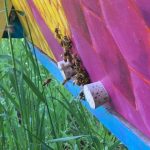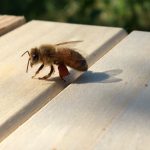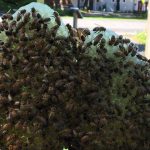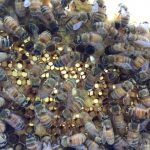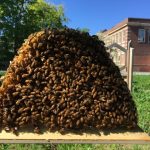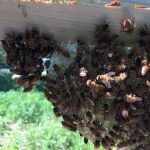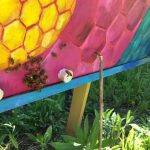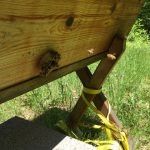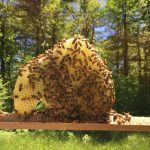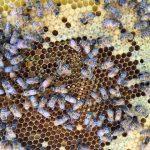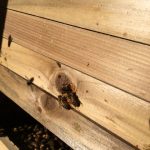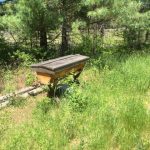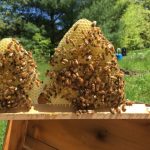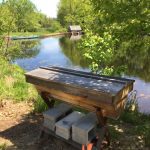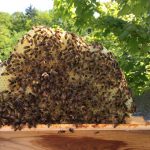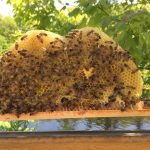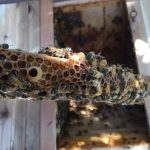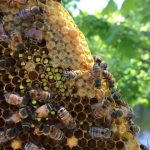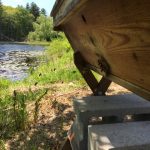Wasp Removal and Hive Inspections
It’s been almost two weeks since I have inspected the hives. When it is early in the season like this, I like to inspect the hive about every two weeks. This allows me to be checking for cross combing or other comb issues and checking on each colony’s growth. Checking the hives frequently in the beginning makes it much easier to deal with comb issues if they arise. The longer these things go left unchecked, the more difficult they are to deal with. It’s also really fun to see the colony growing, usually at rapid speeds during this time.
The Meadow Hive is the colony that is surprising me the most so far this season. They had almost nothing to start with, yet they have been building faster than the other three colonies. Because of their strong growth, I added nine empty bars during this inspection. They look like they need a lot more space to support their lifestyle. They have some form of brood on each of the sixteen bars that they have. There are eggs on ten of these bars! The queen was on the very last bar that I removed for inspection, I guess she was trying to hide. The hive was full of evidence of her though!
Fourteen of the sixteen bars have fully drawn comb and the other two bars are almost complete. They have been storing nectar on every bar above the brood cells. While watching the bees, I noticed that many of the foraging bees were bringing in lots of pollen. There were some bees that were completely covered in pollen. Working this hive was very enjoyable today since the bees were very calm and easy to work with. The only issue that I am running into is the bars. This is my Gold Star Honeybees Hive and the bars are different than my others. These bars are shaped differently so the feel of the inspection is different, as well as, the fit of the bars in the hive.
At the Healing Hive, I did things a bit differently. When I opened it up, I only inspected seven of the seventeen bars. Before starting the inspection, I opened the window and peeked inside. They still had a few empty bars from the bars that I added last time. This and the fact that I saw the queen and a good amount of brood made me feel like I didn’t need to inspect every single bar this time.
Of the seven bars that I inspected, six of them had some form of brood. There were four bars with eggs on them. In this hive too, each bar had some nectar stored above the brood cells. I also found more pollen here. There was pollen on six of the seven bars. Since I found what I needed to after only seven bars, I decided not to go any further. This colony is not growing as quickly as the Meadow Hive, so I only gave them six empty bars to expand on. This was another pleasant inspection with easy going bees. I am really enjoying that!
At Old Frog Pond Farm, before I can work with the bees I have to deal with the wasps. This is the case every year. The lid of the hives has a nice space for the wasps to build their nests. It’s made out of wood and it stays dry, so they really want to make it their home. Of course, I don’t want them there! During the spring is really the only time that I have to deal with them trying to live in the lids, once it’s summer they have moved on.
At Orchard Hive I found one small wasp nest in the lid and there were four wasps there. The flat end of my hive tool has become my go to for destroying wasp’s nest. After dealing with that, I decided to open the observation window before opening the nest area. I was not at all surprised to find a colony of ants in the window. These are the really small ants that do not damage the wood like the carpenter ants. This time, I just left them alone. Sometimes I just want a break from fighting off the other critters.
When I finally got to open the hive, the bees were happy and gentle. They didn’t seem to even notice I was there. This colony is on fourteen bars, but three of them had very small comb on them. They did have some form of brood on twelve of the bars, but only four of them had eggs. That seems like a small amount at this point in the season. During this inspection, I did not find the queen. I did, however, find four queen cups and two of them had larvae in them. I don’t think that they are getting ready to swarm, so they might be replacing their queen. This will be something to keep an eye on.
Last, but not least is the Willow Hive. They also had ants in the window and one wasp’s nest in the lid. Luckily, this time there were only two wasps. After taking care of them, I was able to open the nest area of the hive and see how this colony is doing. They have fifteen bars and all of them have fully drawn comb. There is some form of brood on every bar along with nectar. There was even a small amount of capped honey on one of the bars!
I found eggs on six bars, but I did not see the queen. There was one queen cup, but it was not in use. They seem to be growing well also, so I added nine empty bars for them to fill. Close to the end of the inspection, the wind picked up so I needed to be careful with the combs. The last thing they need is for their comb to break off the bar because I let the wind knock it off. This colony is one of the sweetest that I have worked with. They have acted as if I wasn’t even there poking through their home.
For the most part, all four colonies seem to be doing well. I am a little concerned with Orchard Hive and the lack of eggs, but for now they seem fine. One of the things that I saw in every hive today is comb with a hole in it near the bar. The bees use this to get around the comb more easily. In the hives, I tend to see many bars that have these holes in them and the bees are constantly using them. In the past, many of the colonies have filled in most of the holes by the end of the season. These holes seem to be a very useful tool for them. I enjoy seeing all of the variations of the new combs in each hive. They all do their own thing.
